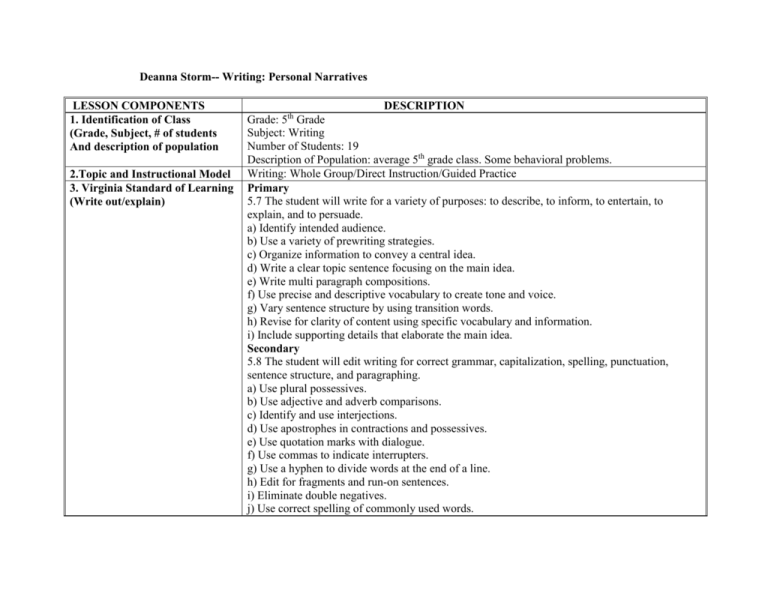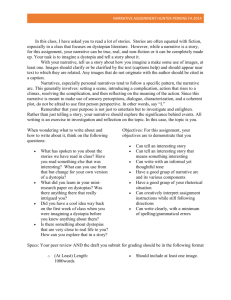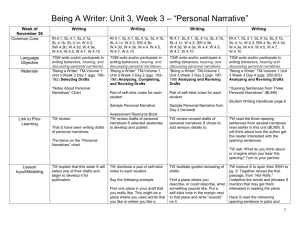File - Deanna Storm`s Portfolio
advertisement

Deanna Storm-- Writing: Personal Narratives LESSON COMPONENTS 1. Identification of Class (Grade, Subject, # of students And description of population 2.Topic and Instructional Model 3. Virginia Standard of Learning (Write out/explain) DESCRIPTION Grade: 5th Grade Subject: Writing Number of Students: 19 Description of Population: average 5th grade class. Some behavioral problems. Writing: Whole Group/Direct Instruction/Guided Practice Primary 5.7 The student will write for a variety of purposes: to describe, to inform, to entertain, to explain, and to persuade. a) Identify intended audience. b) Use a variety of prewriting strategies. c) Organize information to convey a central idea. d) Write a clear topic sentence focusing on the main idea. e) Write multi paragraph compositions. f) Use precise and descriptive vocabulary to create tone and voice. g) Vary sentence structure by using transition words. h) Revise for clarity of content using specific vocabulary and information. i) Include supporting details that elaborate the main idea. Secondary 5.8 The student will edit writing for correct grammar, capitalization, spelling, punctuation, sentence structure, and paragraphing. a) Use plural possessives. b) Use adjective and adverb comparisons. c) Identify and use interjections. d) Use apostrophes in contractions and possessives. e) Use quotation marks with dialogue. f) Use commas to indicate interrupters. g) Use a hyphen to divide words at the end of a line. h) Edit for fragments and run-on sentences. i) Eliminate double negatives. j) Use correct spelling of commonly used words. 4. Rationale for Instruction 5. Lesson Goals Know, Understand, Be Able to Do… 7. Evaluation State ways to link to learning Objectives k) Identify and use conjunctions. Students have been working on preparing for the writing SOL in March for the past months. This lesson is a continuation of a writing unit on Personal Narratives from the Being A Writer series. Students are learning what it means to write about their own lives in order to become better wellrounded writers. Because the SOL is on the computers, students will be using the computers to do their writing in class to practice typing. Students will know: - What a personal narrative is and how it is different from other kinds of writing - Why writers need to use sensory details in their works - How to work with their writing partner to get help and feedback - That during teacher writing conference that they need to ask their partners for help when I am working with another student Students will understand: - that authors write personal narratives to share their life stories - that sensory details are important to include in writing Students will be able to: - Hear and discuss a personal narrative - Listen sensory details in a passage - Draft personal narrative - Ask one another questions about their writing - Ongoing Assessment—Asking questions throughout the lesson o What makes personal narrative writing different from other kinds of writing? o What did you imagine seeing as you listened to this passage? What did you imagine hearing? o What other senses did you imagine using? - Teacher Conference o Confer with individual students on their selected draft that they are going to publish. Help them extend their personal narratives. Record responses and make notes of what needs to be refocused on Why did you choose this (even/memory/thing) to write about? What else do you remember that you can add to the narrative? What words are you using to describe (senses)? What other experiences from your own life you might want to write about. - 8. Resources 9. Procedures of specific model 10. Provisions for individual Draft to publish o Students pick their favorite personal narrative they have write about in order to expand on for a publication. This needs to be edited and worked to be the best possible piece that they would want to have published if they were a famous writer. White board, dry erase markers, laptops, usb drives, Being A Writer teacher manual, Knots on my Yoyo string by Jerry Spinelli, conference sheet, Personal Narrative poster, markers - (8:30) Have students go and sit with their writing partners with their laptops (closed) and their usb drives - (8:35) Review what is a personal narrative? What makes it different from other types of writing? o If students feel we need to add to our personal narrative poster, we will add on new details about what we have learned about personal narratives - (8:40)We are going to read another Spinelli memory called Mrs. Seeton’s Whistle. As you listen think about what he does to make this memory feel real to us o Vocab—Before Reading Flanking the ice—on either side of the ice Castanet- a musical instrument that makes a clacking noise Relishing- really enjoying - (9:00)Explore sensory details o What did you imagine seeing as you listened to this passage? Hearing? o What other senses did you imagine using? o Have a copy passed out. Pairs underline the words that did help them use their senses to imagine. When done ask why these words made you imagine and how o Point out the Spinelli’s memory becomes real to us because he helps us imagine using sensory details in his writing - (9:10)Today we will continue on personal narratives and taking a little time to focus on sensory details. Continue what you have worked on, or if you want to try something new to write about that is a personal narrative, work on that. - (9:10) as students work call on Virginia, Trey, Jack, and Brandon one at a time and have a teacher conference on the piece they chose to edit for publish. Follow the book’s guideline on teacher conference Suggested Vocabulary—go over words flanking the ice, castanet, relishing. Differences Provide individual support for those students that are being conferenced based on their writing needs.








